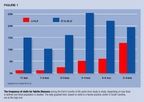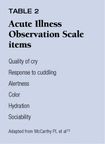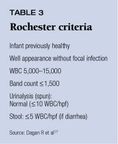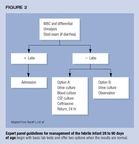Managing the febrile infant: No rules are golden
A single "best way" just doesn't emerge from the data available. What's a pediatrician to do? Know the science of medicine, but also be ready to practice the art.
Managing the febrile infant: No rules are golden

By Charles G. Prober, MD
A single "best way" just doesn't emerge fromthe data available. What's a pediatrician to do? Know the science of medicine,but also be ready to practice the art.
"Science is the father of knowledge, but opinion breeds ignorance."
--Hippocrates (c 460377 BC)
The Canon Law IV
"The greater our knowledge increases the more our ignorance unfolds."
--John F. Kennedy (19171963)
Rice University, 1962
The words of Hippocrates and Kennedy capture the dilemma of definingthe "optimal" evaluation and management of the young febrile child.The pediatrician faces both knowledge and ignorance when evaluating childrenwith febrile illnesses. The literature on the management of febrile infantsis voluminous; between 1960 and 1995, more than 300 articles were publishedon the subject. Abundant opinion on the topic has also been voiced in editorials,commentaries, and practice guidelines.13
Nonetheless, I have yet to meet a seasoned pediatrician who always feelscomfortable when managing young febrile children. Many practitioners donot agree with proposed practice guidelines, surveys show.4
I believe that the prudent evaluation and management of young febrilechildren is as much an art as a science. The art is reflected in thoughtfulattention to parental observations and concerns, coupled with a carefulphysical examination of the child. The science derives from the knowledgethat fever may indicate a serious bacterial infection (SBI), especiallyamong the very young; that the role of laboratory tests in the evaluationof febrile children is controversial; and that the risk of missing infectionmust be weighed against the consequences of excessive testing and treatment.
There is no such thing as a risk-free plan for managing all childrenwith febrile illnesses. Children with serious infection may have a paucityof symptoms, a normal examination, and normal laboratory tests. On the otherhand, children without infection may suffer trauma from theperformance ofdiagnostic tests or adverse effects from overzealous antibiotic therapy.The job of the thoughtful clinician is to minimizerisk from all sources--todo no harm.
My discussion of how best to do that focuses on the following questions:How likely is it that infants and children who have a febrile illness withouta source have an underlying serious bacterial infection? What diagnosticapproaches and management strategies have been proposed to identify infantsat low risk of serious bacterial infection? What rules should cliniciansfollow as they evaluate and manage individual febrile infants?
"Fever" and other basic terms
The definition of fever varies among authors, the range generally beingbetween 38.0° and 39.0° C by rectum. For ease of reference, Table1 provides Fahrenheit equivalents for Celsius temperatures. Based upon asurvey of pediatric and emergency medicine residency program directors,a rectal temperature of 38.0°C has been proposed as the lower limitof fever.1 When reviewing published studies, however, it is importantto recognize that the definition of fever varies.

Several other definitions are also relevant. "Fever without source"assumes that the etiology of the fever is not apparent after a careful historyand physical examination. The most widely used definition of a "seriousbacterial infection" includes meningitis, septicemia, bone and jointinfection, urinary tract infection, pneumonia, and bacterial gastroenteritis.1But some authors have chosen to use the term "serious illness"rather than "serious bacterial infection," and have included asepticmeningitis, abnormal serum electrolytes, and hypoxia in their definition.5Once again, caution is advised when trying to compare studies that use differentdefinitions of adverse outcomes.
In general, recommendations regarding the management of the febrile childdepend on the age of the patient. Typical age categories used in the literatureare younger than 1 month, younger than 2 months, younger than 3 months,and from 3 to 36 months.
Fever and SBI in infants under 3 months of age
The reported frequency of visits for fever during the first three monthsof life ranges from 1.1% to 15.6%, depending on the definition of feverand the population studied. For example, 1.1% of 2,920 infants under 3 monthsof age presenting to the primary care unit and emergency department of theRhode Island Hospital had rectal temperatures >=38° C.6In contrast, as illustrated in Figure 1,15.6% of 1,341 infants younger than3 months of age seen in the Family Practice Center at Charleston County,SC, had rectal temperatures >=37.8° C, with 1.8% having temperatures>=38.3° C.7

The likelihood that a febrile infant younger than 3 months of age hasa serious bacterial infection also varies widely.8 In 16 studiesthat included 3,082 infants, the risk of serious bacterial infection rangedfrom 0.7% to 18.5%. The incidence of bacteremia ranged from 0 to 11.5% andthe incidence of meningitis, from 0 to 6.5%.9
Viruses are much more likely causes of febrile illness than bacteria.One prospective study of 233 previously healthy febrile infants ¾3months of age who were hospitalized with suspected sepsis noted that overhalf the documented infections were caused by viruses (58%) rather thanbacteria (8%).10
The management of young infants with febrile illnesses has changed substantiallyover the last two or three decades. As recently as the mid-1980s a commonapproach, especially for infants under 60 days of age, was to hospitalizeall those with fever and treat them empirically with antibiotics.11There has been a softening of this position over the years. For example,practice guidelines written by a panel of experts in pediatrics, infectiousdiseases, and emergency medicine in 1993 supported outpatient managementof febrile infants under 60 days of age if they were at low risk of seriousbacterial infection.1
These guidelines have generated substantial controversy.12Although they represent a thoughtful approach to the problem of the febrileinfant, they should be regarded as a starting point,13 not theonly approach. In a recent national survey of 600 pediatricians, 64% ofthe respondents said they knew of the practice guidelines, but they gavethem a perceived helpfulness score of only 6 on a 10-point scale.14Thirty-three percent of the respondents felt that the guidelines were "toocookbook." In another survey, only about 10% of primarycare pediatriciansin Utah complied with the guidelines when managing a hypothetical febrileinfant less than 2 months age.4
Identifying infants at low risk
One approach to limiting the number of infants who need to be hospitalizedfor empiric antimicrobial therapy is to identify those who are unlikelyto have serious bacterial infections.
Acute Illness Observation Scale. Early studies to identify febrile infantsat low risk of serious illness evaluated an observational scale developedby investigators at Yale University School of Medicine, the Acute IllnessObservation Scale.15 This scale was composed of six items (Table2): quality of crying, reaction to parent stimulation, state variation,color, state of hydration, and response (talk, smile) to social overtures.The rater assigned a value ranging from 1 (normal) to 5 (severe impairment)to each item. When used together, researchers found, these six items hada specificity of 88% and a sensitivity of 77% for detecting 37 serious illnessesamong 312 febrile children less than 24 months of age. Only 2.7% of childrenwith total scores under 10 had serious illness, whereas 92.3% of those witha score over 16 had a serious illness.15 In a subsequent studyof 350 patients under 24 months of age evaluated in either an emergencyroom or a suburban private practice, 28 of 36 serious illnesses were detectedby a combination of abnormal history or physical examination; three additionalserious illnesses were detected on the basis of an abnormal score on theAcute Illness Observation Scale.16 Five of 36 seriously ill childrenhad unremarkable histories, normal exams, and a normal Acute Illness ObservationScale score.

Rochester criteria. Attempts to develop more sensitive ways to detectserious illness, especially in infants less than 3 months of age, have combinedhistorical, physical, and laboratory evaluations. The most extensively evaluatedcriteria were developed by investigators at the University of RochesterMedical Center (Table 3).17

To satisfy the Rochester criteria for low risk of serious bacterial infections,infants must be previously healthy and well appearing, without evidenceof focal infection on physical examination. Their white blood cell (WBC)count must be between 5,000 and 15,000/mL, band count less than 1,500/mL,spun urinalysis normal (<10 WBC/ high power field), and if they havediarrhea, a sample of their stool must have fewer than 5 WBC/high powerfield. In the initial publication, only one of 144 febrile infants under3 months of age who met all of these criteria had serious infection.17In contrast, 22 of 89 (25%) infants who did not meet the low- risk criteriahad serious infection.
The Rochester criteria have been evaluated in a number of subsequentstudies. In a meta-analysis of 14 investigations evaluating infants under90 days of age, only 1.4% of infants who satisfied the Rochester criteriahad serious bacterial infection; 1.1% had bacteremia and 0.5% had bacterialmeningitis.8 In a study of 511 febrile infants under 60 daysof age who satisfied the Rochester criteria, only five had serious bacterialinfection; three had urinary tract infections and two had unsuspected bacteremia.18In contrast, 61 of 494 infants who did not satisfy the low-risk criteria(12.3%) and 16 of 72 "toxic infants" (22.2%) had serious infection.18
A modification of the Rochester criteria that includes an erythrocytesedimentation rate (ESR) </=30 mm/hr and a C-reactive protein (CRP) </=20mg/L has been evaluated in infants under 31 days of age in a study fromTaiwan.19 Six percent of the 134 infants with temperatures of38° C or higher who met these criteria had serious bacterial infections;one child (0.7%) had meningitis.
Management of young febrile infants
The 1993 expert panel practice guideline suggested two options for themanagement of the non-toxic febrile infant 28 to 90 days of age (Figure2).1 The suggested work-up began with a WBC and differential,urinalysis, and examination of the stool for WBC if the infant had diarrhea.If the WBC count was ¾5,000 or >=15,000/mL, if the band count was>=1,500/mL, or if there were >=10 WBC/high power field of urine or>=5 WBC/high power field of stool, the guidelines called for admittingthe child to hospital for initiation of empiric antibiotic therapy. If allthe laboratory tests were normal, the guidelines proposed two options. Onewas to obtain a urine culture and observe the infant as an outpatient withoutinitiating antibiotics. The alternate approach was to culture urine, blood,and CSF and start empiric antibiotic therapy.

The strategy of avoiding empiric use of antibiotics in young febrileinfants at low risk of serious bacterial infection was studied prospectivelyin Philadelphia.20 Seven hundred and seven infants, 29 to 56days of age, with temperatures 38.2° C or higher and unremarkable examinations,were randomized to observation in hospital or in an outpatient setting,without antibiotic therapy, if their WBC was ¾15,000/mL and their urinalysis,chest radiograph, and cerebrospinal fluid (CSF) examination were normal.Two hundred and eighty-seven of the infants (32%) satisfied all criteriafor observation alone; 148 were initially observed in hospital and 139 inthe outpatient setting. Only one of the 287 infants was diagnosed with aserious bacterial infection (bacteremia). An additional two patients initiallyassigned to outpatient observation were later admitted to hospital becauseof increasing severity of illness; neither patient proved to have a bacterialinfection. The authors concluded that, with the use of appropriate screeningcriteria, a substantial number of febrile infants can be safely cared foras outpatients without antibiotic therapy. An estimated savings of $3,100was realized for each child managed in this manner.20
A prospective trial of empiric antibiotic therapy given outside the hospitalfor young febrile infants at low risk of serious bacterial infection wasconducted in Boston. Five hundred and three infants 29 to 89 days of age,with temperatures of >=38° C and unremarkable examinations, weregiven two consecutive daily doses of intramuscular ceftriaxone if theirWBC was ¾20,000/mL and their urine and CSF examinations were normal.21Approximately 5% of the infants had serious bacterial infections, despitesatisfying the low- risk criteria. All infants were well at follow-up evaluation,and the infants with documented infections remained well after initiationof appropriate antibiotic therapy. The authors concluded that their protocolavoided hospitalization for most infants at low risk of serious infections.A reduction in almost 1,200 hospital days resulted from this strategy.21
The recommended management of the febrile infant under 28 days of agetends to be more aggressive than the management of the older infant. The1993 expert panel practice guidelines, for example, suggested that all suchinfants should be admitted to hospital for evaluation and empiric antibiotictreatment.1 A recent survey of 1,600 randomly selected pediatricians,family medicine practitioners, and emergency medicine physicians found thatthe majority preferred hospital admission and empiric antibiotic therapyfor these very young, febrile subjects.22 In contrast, a substantialproportion of these practitioners felt that it was acceptable to managea febrile 7-week-old infant with fever and no evidence of focal infectionat home, without antibiotic therapy.
Considering the recent study suggesting that most febrile infants under31 days of age who are at low risk of serious bacterial infection can beidentified, it may be possible to be more conservative in the managementof even our youngest febrile patients.19,23 For the time beinghowever, most physicians will continue to manage these young subjects aggressively.
Fever and SBI in children 3 to 36 months of age
The reported risk of occult bacteremia in febrile children 3 to 36 monthsof age without focus of infection ranges from 3% to 11%. The probabilityof positive blood cultures rises with increasing temperature; positive culturesare uncommon in those with temperatures ¾39° C.1
The child's WBC also predicts bacteremia. A WBC under 15,000/mL in thosewith temperatures >=39° C has a negative predictive value higherthan 98%. That is, less than 2% of bacteremic children will have a WBC ¾15,000/mL.The relative risk of bacteremia is five-fold higher (13.0% vs. 2.6%) ifthe WBC is >=15,000/mL.1
Management, 3 to 36 months
Evaluation and management of the febrile child between 3 and 36 monthsof age without focus of infection on examination remains controversial.The main topics of debate are whether to obtain a CBC and blood cultureand whether to administer empiric antibiotic therapy. The controversy regardingthe use of empiric antibiotics is based on a number of observational andtwo randomized controlled studies suggesting that giving antibiotics atthe time of the initial encounter reduces the adverse consequences of occultbacteremia--persistent fever and development of focus of infection, includingmeningitis.1
Based upon these data, the 1993 expert panel practice guidelines suggestedthat a WBC be obtained if the child's temperature is at least 39° Cand there is no apparent focus of infection (Figure 3). If the WBC is ¾15,000/mL,the guidelines suggest no further workup or empiric therapy; parents shouldbe advised to return if the child's condition deteriorates. If the WBC is>=15,000/mL, the guidelines say to obtain a blood culture and administeran empiric dose of ceftriaxone.1 Many experts do not agree. Theyargue that:
- Occult bacteremia is usually a benign condition that clears spontaneously2,3
- Widespread antibiotic use will continue to foster resistant bacteria and confound the interpretation of subsequent diagnostic tests, including CSF analysis24
- Expectant antibiotic therapy could "jeopardize thoughtful assessment, individualized management, and close follow-up of the febrile child, accentuate fever phobia among parents and physicians, and encourage the all-too-common practice of 'treating fever' with antibiotics."3

It's your choice
It should be evident that the "optimal" evaluation and managementof febrile infants and children remains a subject of debate. To suggestthat there is one single, correct, standardized approach would be inappropriate.When a febrile child presents to a physician's office, clinic, or emergencyroom, evaluation and management will depend on the results of a thoughtfulhistory and carefully performed physical examination. Some clinicians maychoose to supplement their history and examination with selected laboratorytests; others will choose not to order tests. Some physicians will electto initiate empiric therapy for the febrile infant without a source of infection;others will choose to observe without antibiotic therapy. Some golden rulesto consider as one debates the "correct" course of action foran individual child appear in Table 4.

Although there is more than one management strategy for a well-appearingfebrile child who does not have an obvious focus of infection on examination,there is only one approach to the toxic child: prompt evaluation, and initiationof appropriate therapy as soon as feasible.
Given the limitations of our diagnostic evaluations (history, examination,and laboratory tests) and therapeutic options, uncertainty is understandable.We need not aim for a uniform mode of practice. Rather, our goal shouldbe a thoughtful approach to the problem, one that tries to "do no harm"but also assures that febrile infants are carefully observed with the opportunityfor follow-up evaluations as often as necessary. Research on the evaluationand management of the febrile child continues, as does the expression ofexpert opinions in editorials, commentaries, medical education courses,and courts of law. It is unlikely that any single management strategy willfit all situations and define the standard of care in a medicolegal context.
Although no rules are golden, two practices are prudent, especiallyfroma medicolegal perspective. First, laboratory tests are not necessarily required,but if studies are ordered, their results cannot be ignored. An abnormaltest demands some action, at the very least an explanation as to why itis being dismissed. Second, the medical record must accurately reflect theclinical status of the child and the management strategy being pursued.The record should clearly convey the degree of illness. Observations onhow the child interacts with the environment should be noted ("alert,""smiling") and imprecise terms ("irritable," "lethargic,""toxic") should be avoided or defined. These tend to be "loaded"words that mean different things to different people. The chart should beinterpretable by other caregivers and even by potential adversaries, shouldan adverse outcome evolve and a medicolegal issues arise.
The last word
Managing the febrile infant requires weighing the risks and benefitsof testing, hospitalizing, and empirically treating against risks of missinga serious bacterial infection.It is a clinical situation encountered dailythat demands skill and attention, integrating the art and science of medicine.
Acknowledgment:
The author gratefully acknowledges the advice and editorial assistance ofLaura K. Bachrach, MD.
THE AUTHOR is Professor of Pediatrics, Medicine, Microbiology, and Immunologyand Associate Chairman, Department of Pediatrics, Stanford University Schoolof Medicine, Stanford, CA.
REFERENCES
1. Baraff LJ, Bass JW, Fleisher GR, et al: Practice guideline for themanagement of infants and children 0 to 36 months of age with fever withoutsource. Pediatrics 1993;92:1
2. Long SS: Antibiotic therapy in febrile children: "Best-laid schemes..."J Pediatr 1994;124:585
3. Kramer MS, Shapiro ED: Management of the young febrile child: A commentaryon recent practice guidelines. Pediatrics 1997;100:128
4. Young PC: The management of febrile infants by primary-care pediatriciansin Utah: Comparison with published practice guidelines. Pediatrics 1995;95:623
5. McCarthy PL, Lembo RM, Fink HD, et al: Observations, history, andphysical examination in diagnosis of serious illnesses in febrile children¾24 months. J Pediatr 1987;110:26
6. O'Shea JS: Assessing the significance of fever in young infants. ClinPediatr 1978;17:854
7. Pantell RH, Naber M, Lamar R, et al: Fever in the first six monthsof life. Clin Pediatr 1980;19:77
8. Baraff LJ, Oslund SA, Schriger DL, et al: Probability of bacterialinfections in febrile infants less than 3 months of age: A meta-analysis.Pediatr Infect Dis J 1992;11:257
9. Bonadio WA: Evaluation and management of serious bacterial infectionsin the febrile young infant. Pediatr Infect Dis J 1990;9:905
10. Dagan R, Hall CB, Powell KR, et al: Epidemiology and laboratory diagnosisof infection with viral and bacterial pathogens in infants hospitalizedfor suspected sepsis. J Pediatr 1989;115:351
11. Long SS: Approach to the febrile infant with no obvious focus ofinfection. Pediatr Rev 1984;5:305
12. Wittler RR, Cain KK, Bass JW: A survey about management of febrilechildren with source by primary care physicians. Pediatr Infect Dis J 1998;17:271
13. Sectish TC: Management of the febrile infant. Pediatric Annals 1996;25:608
14. Christakis DA, Rivara FP: Pediatricians' awareness of and attitudesabout four clinical practice guidelines. Pediatrics 1998;101:825
15. McCarthy PL, Sharpe MR, Spiesel SZ, et al: Observation scales toidentify serious illness in febrile children. Pediatrics 1982;70:802
16. McCarthy PL, Lembo M, Fink HD, et al: Observation, history, and physicalexamination in diagnosis of serious illnesses in febrile children ¾24months. J Pediatr 1987;110:26
17. Dagan R, Powell KR, Hall CB, et al: Identification of infants unlikelyto have serious bacterial infection although hospitalized for suspectedsepsis. J Pediatr 1985;107:855
18. Jaskiewicz JA, McCarthy CA, Richardson AC, et al: Febrile infantsat low risk for serious bacterial infection--an appraisal of the Rochestercriteria and implications for management. Pediatrics 1994;94:390
19. Chiu C-H, Lin T-Y, Bullard MJ: Application of criteria identifyingfebrile outpatient neonates at low risk for bacterial infections. PediatrInfect Dis J 1994;13:946
20. Baker MD, Bell LM, Avner JR: Outpatient management without antibioticsof fever in selected infants. N Engl J Med 1993;329:1437
21. Baskin MN, O'Rourke EJ, Fleisher GR: Outpatient treatment of febrileinfants 28 to 89 days of age with intramuscular administration of ceftriaxone.J Pediatr 1992;120:22
22. Wittler RR, Cain KK, Bass JW: A survey about management of febrilechildren without source by primary care physicians. Pediatr Infect Dis J1998;17:271
23. Baraff U: Management of febrile neonates: What to do with low-riskinfants. Pediatr Infect Dis J 1994;13:943
24. Wald ER, Dashefsky B: Cautionary note on the use of empiric ceftriaxonefor suspected bacteremia. Am J Dis Child 1991;145:1359
Artificial intelligence improves congenital heart defect detection on prenatal ultrasounds
January 31st 2025AI-assisted software improves clinicians' detection of congenital heart defects in prenatal ultrasounds, enhancing accuracy, confidence, and speed, according to a study presented at SMFM's Annual Pregnancy Meeting.